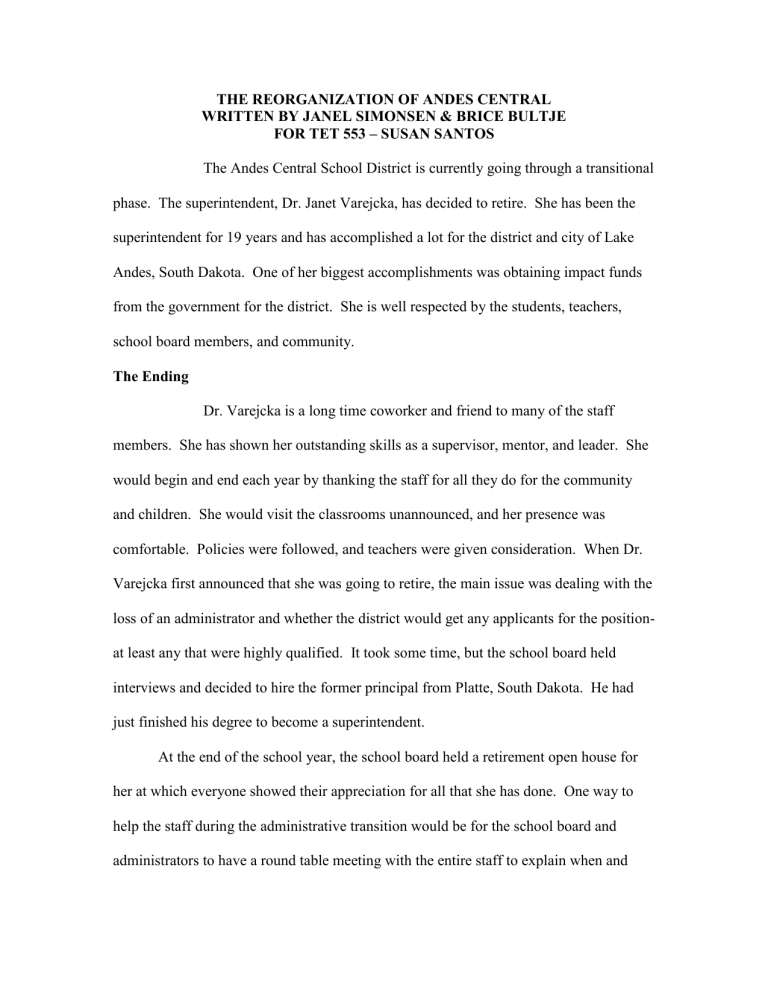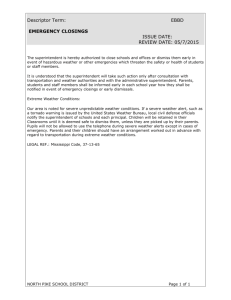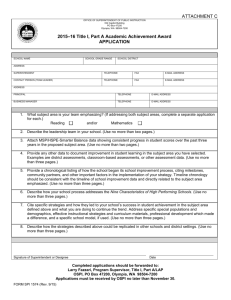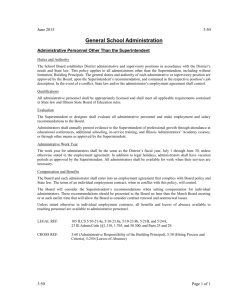Organizational Transition

THE REORGANIZATION OF ANDES CENTRAL
WRITTEN BY JANEL SIMONSEN & BRICE BULTJE
FOR TET 553 – SUSAN SANTOS
The Andes Central School District is currently going through a transitional phase. The superintendent, Dr. Janet Varejcka, has decided to retire. She has been the superintendent for 19 years and has accomplished a lot for the district and city of Lake
Andes, South Dakota. One of her biggest accomplishments was obtaining impact funds from the government for the district. She is well respected by the students, teachers, school board members, and community.
The Ending
Dr. Varejcka is a long time coworker and friend to many of the staff members. She has shown her outstanding skills as a supervisor, mentor, and leader. She would begin and end each year by thanking the staff for all they do for the community and children. She would visit the classrooms unannounced, and her presence was comfortable. Policies were followed, and teachers were given consideration. When Dr.
Varejcka first announced that she was going to retire, the main issue was dealing with the loss of an administrator and whether the district would get any applicants for the position- at least any that were highly qualified. It took some time, but the school board held interviews and decided to hire the former principal from Platte, South Dakota. He had just finished his degree to become a superintendent.
At the end of the school year, the school board held a retirement open house for her at which everyone showed their appreciation for all that she has done. One way to help the staff during the administrative transition would be for the school board and administrators to have a round table meeting with the entire staff to explain when and
how the new superintendent will take over. The staff should be updated often on what is happening in the head office, especially as it pertains to the school’s financial issues that might affect staff or programs. Secondary changes such as dress code, discipline policies, in-services, etc. should also be discussed. The staff needs to understand that the new superintendent may handle things differently and they must make decisions and act on what really matters. Dress code may not be worth arguing about, while discipline policies are more important.
Some of the changes that the staff will have to deal with are physical changes such as dress code, but many changes are emotional or personal. Dr. Varejcka’s absence will affect the friendships and interpersonal relationships of the entire staff. The district must consider that many certified and classified staff members may be angry or upset over the changes that occur during this transition. The school board or administrators should be available to discuss these feelings. They could also compensate for the losses
(Bridges 2003, p. 30) by continuing to allow them to wear jeans on Fridays or leave coffee and treats in the teachers’ lounges. They could continue to hold weekly half-day in-services for the teachers to complete the extra work that may be required of them.
The Neutral Zone
This administrative transition is going to affect all of our district’s staff members.
At the end of the school year a lot of rumors were floating around about the changes that were going to occur with the retirement of Dr. Varejcka and the appointment of the new superintendent. Many staff members think this to be a change for the worse for the simple fact that things had been running so smoothly for the last 19 years under the direction of
Dr. Varejcka. Many staff members stated that they didn’t like what they heard about the
new superintendent or are simply resistant or uncomfortable with change. We, as teachers, all have to go into this next school year with an open mind. Many of us dislike change, particularly one of this magnitude. Teachers fall into a routine when they have taught more than few years and some lose the drive to improve or make changes in their teaching style. Many arrive at school at 8:00 AM, go to the file cabinet, use last year’s tests or worksheets, and walk out the door at 4:00 PM. In order to be effective teachers, we need to be creating different lessons that are appropriate for each group of students every year. Having a new superintendent may just encourage some teachers to accept the transitional process which, in turn, could make them more efficient and productive teachers. Administrators can be very strict or very flexible. Flexibility in an authority figure is usually not a good thing. When following the given policies and procedures, everyone, teachers and students, know what is going to happen and when.
With all of these problems and rumors arising, the school district must find a way to help the staff through this neutral zone. We first need to remember that this is a difficult time, “…but also a creative time” (Bridges, 2003, p.44). Now is the time to try new ideas, lessons, activities, etc. William Bridges makes several suggestions on how the administration could accomplish this task (2003, p.45-46). They should protect the staff from any changes other than the new administrator. If some other changes are necessary, try to maintain the status quo in as many areas as possible. Staff meetings should be held to review the school’s policies and procedures as well as to define roles and answer questions. Setting short-term goals will ensure successes rather than failures.
Offering training in any new programs will make the staff feel more confident. Finally, we need to remember that we are in this transition together. A temporary “Transition
Monitoring Team” (TMT) (Bridges, 2003, p. ) could be made up of a variety of staff members such as lower level administrators, teachers, and paraprofessionals. They would monitor not manage the transition. The TMT would act as a go between when questions or problems arise.
William Bridges refers to two questions we need to ask ourselves when in the neutral zone (2004, p.87-88).
1.
“What is it time to let go of in my own life right now?” Or in this situation, what are we going to have to let go of in school. Many teachers are going to have to adopt the philosophy of the new superintendent remembering that change can be a good thing.
2.
“What is backstage…?” Just maybe some very good things will happen with this new transition. All of us need to keep an open mind about the forth coming year remembering things may just turn out better than ever.
A New Beginning
It is difficult to discuss a new beginning when we are currently in the neutral zone. Our new beginning will not occur for some time yet or at least until the next school year gets underway.
The Andes Central School District must be aware that some members of the staff may resist this new beginning. It may remind them of the loss of Dr. Varejcka causing anxiety. It may also represent a gamble with the possibility of failure (Bridges, 2003, p.58-59).
We need to make sure that there is a clear understanding of the desired outcome.
Bridges “4 P’s” – purpose, picture, plan, and part to play – come into action. A clear
purpose must be set for this transition. We need to understand that our school cannot run smoothly without a superintendent and that he is there to run the school from a business perspective. The school interviewed several applicants and chose Mr. Mueller has most qualified for the job. We also need to understand the purpose of our school and educators. The staff needs a mental and/or physical picture of the given purposes. A diagram of hierarchy beginning with the superintendent and ending with successful students could be helpful. Planning for the purpose or desired outcome is necessary. We must consider exactly what needs to be done to achieve a financially stable school as well as one that runs smoothly and produces high-achieving students. How we will accomplish this or the steps we will take should also be a part of the plan. Finally, every staff member must understand what part they are to play. We are all vital members of the educational process.
Once we are well into our new beginning, we could reinforce this stage. Bridges suggests several rules on how to reinforce the beginning. The organization should be consistent, ensure quick successes, symbolize the new identity, and celebrate the success.
Reference List
Bridges, William. (2003). Managing Transitions: making the most of change (2 nd
ed.).
Da Capo Press.
Bridges, William. (2004). Transitions: making sense of life’s changes (2 nd ed.). Da
Capo Press.







